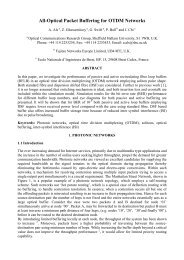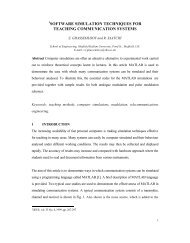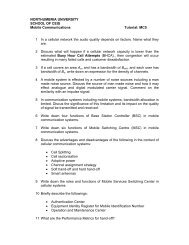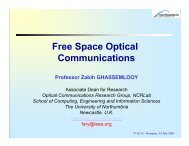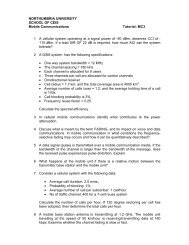<strong>Performance</strong> <strong>of</strong> <strong>sub</strong>-<strong>carrier</strong> <strong>modulated</strong> FSO communication link 353 Figure 5 The outage probability against the power margin, m (dBm) for 1, 2 and 4 photodetectors using EGC diversity Figure 6 Diversity gain against number <strong>of</strong> independent photodetectors at BER and P o <strong>of</strong> 10 –6 Figure 5 shows the extra power margin required to achieve a certain outage probability P o with and without spatial diversity. The gain <strong>of</strong> employing diversity is quite apparent from the figure just as in the case under the BER performance metric. For instance at P o <strong>of</strong> 10 6 , a diversity gain <strong>of</strong> nearly 30 dB is predicted and this increases to about 43 dB with four photodetectors. This significant gain is down to the fact that with multiple photodetectors, more independent irradiances are received. In the case <strong>of</strong> a single photodetector with an aperture size same as that <strong>of</strong> N-photodetectors combined, the increased noise level from background sources tends to cancel out any potential gain from aperture averaging that large aperture area pr<strong>of</strong>fers. To further elucidate the gain <strong>of</strong> employing spatial diversity for FSO in atmospheric turbulence, we show in Figure 6 the predicted diversity gain (ratio <strong>of</strong> SNR or m with one
354 W.O. Popoola Z. Ghassemlooy and V. Ahmadi photodetector to that <strong>of</strong> N-photodetectors at the specified BER or P o ) as a function <strong>of</strong> the number <strong>of</strong> photodetector N. As the number <strong>of</strong> photodetectors increases, the diversity gain plateaus. It should be noted that both P o and BER are different by definition; but they both resulted in the similar inferences as seen in Figure 6. However, it should be motioned that using an array <strong>of</strong> photodetectors adds to the cost and design complexity. 5 Conclusions In this article, we presented the performance <strong>of</strong> SIM FSO in negative exponential atmospheric turbulence. The outage probability and BER expressions have been presented as well as an expression for the BER upper bound. We equally derived expressions for the stated metrics with photodetector array as way <strong>of</strong> ameliorating scintillation effect. The gain in power from the adoption <strong>of</strong> photodetector array has also been presented. A diversity gain <strong>of</strong> ~50 dB is predicted at BER <strong>of</strong> 10 –6 with just two independent PIN photodetectors in fully developed speckle. And as more photodetectors are added, the diversity gain value tends toward an asymptotic value. Although, P o and BER are different metrics by definition but they resulted in similar inferences. References Agrawal, G.P. (2002) Fiber-optic Communication Systems. New York, NY: Wiley-Interscience. Andrews, L.C., Phillips, R.L. and Hopen, C.Y. (2001) Laser Beam Scintillation with Applications. Bellingham, WA: SPIE. Bloom, S., Korevaar, E., Schuster, J. and Willebrand, H. (2003) ‘Understanding the performance <strong>of</strong> free-space optics’, Journal <strong>of</strong> <strong>Optical</strong> Networking, Vol. 2, pp.178–200. Elon Grave, J. and Drenker, S. (2002) ‘Advancing free space optical communication with adaptive optics’, Lightwave, Vol. 19, pp.105–113. Gagliardi, R.M. and Karp, S. (1995) <strong>Optical</strong> Communications. New York, NY: John Wiley. Garcia-Zambrana, A. (2007) ‘Error rate performance for STBC in free-space optical communications through strong atmospheric turbulence’, IEEE Communication Letters, Vol. 11, pp.390–392. Goodman, J.W. (1985) Statistical Optics. New York, NY: John Wiley. Gradshteyn, I.S. and Ryzhik, I.M. (1994) Table <strong>of</strong> Integrals, Series, and Products. London, UK: Academic Press, Inc. Huang, W., Takayanagi, J., Sakanaka, T. and Nakagawa, M. (May 1993) ‘Atmospheric optical communication system using <strong>sub</strong><strong>carrier</strong> PSK modulation’, ICC 93, IEEE International Conference on Communications, Vol. 3, pp.1597–1601 (Geneva). Isaac, I., Kim, B.M. and Korevaar, E. (2001) ‘Comparison <strong>of</strong> laser beam propagation at 785 nm and 1550 nm in fog and haze for optical wireless communications’, SPIE Proceeding: <strong>Optical</strong> Wireless Communications III, Vol. 4214, pp.26–37. Karp, S., Gagliardi, R.M., Moran, S.E. and Stotts, L.B. (1988) <strong>Optical</strong> Channels: Fibers, Cluds, Water and the Atmosphere. New York, NY: Plenum Press. Kedar, D. and Arnon, S. (May, 2004) ‘Urban optical wireless communication networks: the main challenges and possible solutions’, IEEE <strong>Optical</strong> Communications, Vol. 42, pp.s2–s7. Killinger, D. (2002) ‘<strong>Free</strong> space optics for laser communication through the air’, Optics and Photonics News, Vol. 13, pp.36–42.




